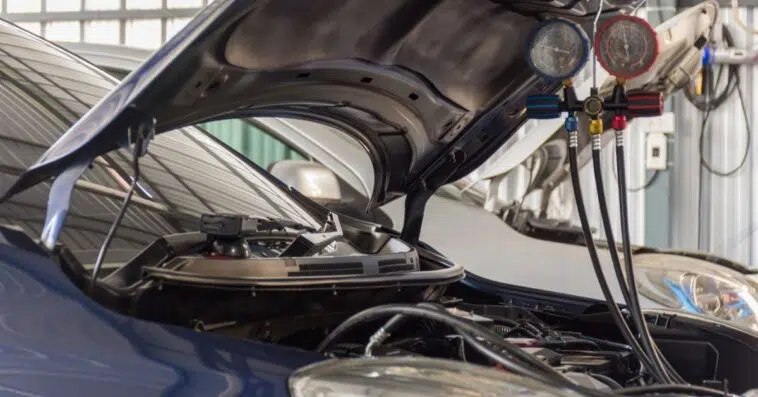When you have an overcharged ac in your car, there are possibly two calls you can make. First, do it yourself (only you have much knowledge about the mechanisms and technology), and second, allow your mechanic to have a look at it.
If my opinion matters to you, I ask you to make the second choice. Yes, ask your mechanic to solve this issue.
However, mechanics are specialized in this field of work, and only certified individuals are granted permission to remove coolant from the vehicle.
If you happen to be a novice, it is better not to indulge yourself in this. If you are caught doing it, you might be penalized. So, I say, let your mechanic do it.
These chemicals are very harmful, and if not handled properly, they can pose several threats to humans and the environment.
Air Conditioning systems are pretty complicated to understand, and it has various components and sections that need attention when dealing with it. So, if you want to know about it, I’ll tell you through this article.
So first we need to learn how this AC system works in your car!
TABLE OF CONTENTS
How Does A Car AC Work?
A car air conditioning has five primary components that make cooling possible. These components are:
- Compressor.
- Condenser.
- Accumulator or receiver or dryer.
- Evaporator.
- Expansion valve.
The compressor is the workhorse of this entire system. First, this component receives the low-pressure gas, which gets compressed into high-pressure gas and pumped out of the discharge side of the compressor. After getting discharged, this gas flows into the condenser.
Next, the condenser allows the cool air to flow over the sections, cooling the high pressure and high-temperature gas, and the gaseous state transforms into a liquid state.
Then, this high-pressure liquid flows through the accumulator. There is a desiccant bag inside that absorbs moisture. Moisture needs to be absorbed, and the liquid needs to be filtered. If not, it can be a potential threat and can contaminate the Freon or refrigerant.
There is a high-side service port located in between the accumulator and expansion valve.
Next, this high-pressure liquid flows through the expansion valve (TXV). This expansion valve allows the high-pressure liquid to expand and transform into a low-pressure liquid.
Now, this low-pressure liquid flows directly into the evaporator. In the evaporator, the low-pressure liquid starts to boil and transform itself into a low-pressure gas.
The low-pressure gas chills the walls of the evaporator and blower pushes this cooled and chilled air through the vents that are installed in your car’s dash.
The low-side service port lies within the expansion valve and the compressor. Then the low-pressure gas flows back into the compressor for another cycle. This is how it works.
Additionally, a lot of cars have a TXV system. The TXV valve is used for making the cooling pretty efficient. The TXV system has a sensor bulb that is installed just at the outlet of the evaporator.
This continuously adjusts the flow of Freon through the expansion valve to enter the evaporator based on the evaporator’s temperature and pressure.
The temperature of the outlet is used to regulate the temperature of the TXV valve, and it sets the MOT (Maximum Operating Temperature) at the outlet.
Then it flows through the low-side service port, and you can mechanics using a low-side gauge to charge your system.
When you add refrigerant, the pressure bar on the low side rises until it reaches maximum operating pressure, which is normally 35 PSI.
Now, if the pressure is over the 35 PSI, even if the system is fully charged, adding extra Freon or coolant will not read on the low side. Instead, you will have to read it using a high-pressure gauge by hooking it up with the high-pressure service port.
Using the only type of gauge can create problems associated with overcharging and undercharging for cases like this.
Now that we have learned about how the ac system works, I am going to tell you how to fix your overcharged AC all by yourself!
How Do You Fix An Overcharged Car AC By Yourself?
Fixing an overcharged ac outside can be very dangerous, so perform this task at your own risk. The overcharging of your AC over a short while is primarily because of the Freon you have there.
To be sure, you need to hook it up with a pressure gauge. If this gauge reads the pressure around the ’60s or more, the AC has some serious business.
An overcharging AC will work fine in cooler temperatures, but the gas inside the AC compressor expands and produces overfilled conditions when the temperature rises.
When you have your AC blowing out warm air, the pressure is high; all you have to do is release that pressure using a hose.
Before you try to release the pressure, you need to close the vent and connect the hose. Then, after connecting it securely, slowly let the pressure out.
- Caution: When the gas comes out, it is freezing cold and can burn your hand, so wear thick fabric gloves. Also, it is recommended that you get a goggle on because if this gets in your eyes, you will go blind. I do not want that. Consider taking proper precautions.
- Note: Look; the chemical (Freon or coolant, whatever you call it) is very harmful to your and the surroundings. To be able to do it, you have to be certified in the first place. Because this is an illegal business, and if you are caught, it is going to be bad.
The second way is to let a mechanic do the job because the mechanic has such equipment to complete this risky task efficiently and easily.
How Do I Know If I Have An Overcharged Or Undercharged AC?
If you want to know why your ac is blowing hot air in your face, this is probably because of two reasons. First, the ac system is undercharged and needs a charge. And second, it is having overcharging problems.
To be sure, you would need a low-side pressure gauge. Next, connect the hose to the outlet, keeping all the vents shut off. If the pressure jumps up and down, it could mean it does not have much coolant or needs to be fixed.
It would be better if you had a dual gauge or if you could buy one. But, still, you can work with the basic single gauge.
To know what is actually going in there, you need to know the temperature outside. So, turn off your car, move out and keep an eye on the gauge.
Do not worry if you see the pointer going up in the red zone because your car is currently off, and this is a normal equalization process between the low and high sides. You need to wait, leave it for a few minutes, and you will see the pointer has come to a halt. This is known as static pressure.
This static pressure does not mean much, and now you need to reference it with your outside temperature.
Static Pressure To Temperature
| Fahrenheit: | PSI: |
| 70 Degrees | 71 PSI |
| 75 Degrees | 78 PSI |
| 80 Degrees | 86 PSI |
| 85 Degrees | 95 PSI |
| 90 Degrees | 104 PSI |
| 95 Degrees | 114 PSI |
Now, if your outside temperature is somewhere around 90’s, the static pressure inside the system will be around 103 to 104 PSI. Now, if you see the pointer around 130, this indicates the pressure inside the system is relatively higher than the outside, and it is overcharged.
Or, if your static pressure went up to only 71 PSI, which is lower than the outside temperature, you need to charge the system up. However, if the temperature knocks around the 70’s, there is no need to do anything.
This is a sure-fire way to know if your ac is overcharged or undercharged. If you want more, you can keep an eye and look for these ac diagnostic quick tips mentioned below:
Tips To Find An Overcharged AC
- Engine failure.
- Higher pressure.
- Not cooling.
- Faulty compressor.
How Should You Recharge Your Car AC?
To recharge your ac, you need some gears. It is the toughest part, and if you do not have the correct tools, the process will not be successful.
Here is what you need:
- Manifold gauges.
- Vacuum pump.
- AC Vacuum pump.
- Scales (for weighing coolant).
- Coolant can tap, and of course.
- Coolant.
Using safety goggles and gloves is a must.
To recharge your ac system, you need refrigerant. To know which product to use, you can open up the bonnet and take a look at the plastic trim before the engine. There you can find a sticker where you will get to see which type of refrigerant your car uses.
Generally, cars use the most common 134a refrigerant. Also, you will get to see how much refrigerant you should add. That is why we have mentioned a scale here to measure the amount you should add. The numbers need to match. Putting up extra coolant will overcharge your ac.
Step 1
The first thing you will do is use the vacuum pump to pull out the moisture present in the ac system. Moisture can destroy your ac systems badly.
So, when you use the vacuum pump, it will draw out the moisture present in the compressor, evaporator, ac lines, and condenser. If you fail to do it, you are probably wasting your time, and moisture will crush your system anytime soon in the future.
Step 2
The second step is pretty basic, i.e., recharging your ac system with the refrigerant.
Pretty simple? Let’s go!
Wait, did you put on your gloves? Go get them!
Recharging The AC System
The very first thing you need to do is to connect the manifold gauges to your ac system. Take your time and make the connection secure. Next, you have to make sure the valves are in closed positions.
In the gauge set, the blue side is the low-pressure side, the red is the high-pressure and side, and the middle hose will be for recharging the system with coolant. But, first, let me tell you that the low and high-pressure hoses will only fit into their respective sides.
To connect the hoses, all you have to do is push down, slide it over and let go. Pretty easy, right? After connecting, make sure they do not come off. Now open the valves.
Now it is time to use the vacuum.
The third hose should be connected to your vacuum pump. Tightening them with your hand is enough. There are gaskets in there that will do the job. Again, do not use pliers and other stuff.
If you have any refrigerant in your system, get it professionally evacuated. This refrigerant is pretty nasty for the atmosphere, so be environmentally responsible.
Now that the hoses are connected, and everything is secure, let’s turn the vacuum pump on.
After turning the pump on, turn on the gauges, turn it on for a few minutes and turn it off. You will get a reading of the vacuum present in the ac system. Let the system sit for an hour, check the reading.
If the reading value matches with the previous reading and does not leak at all, it means you have your ac system is alright, i.e., the ac system is completely sealed.
Now that you are sure of no leaks, it’s time to run the pump for another 45 minutes. Turn on the vacuum and open up the valves again. This is going to pull out all the moisture in the system. Now go get something to do for 456 minutes and come back after.
After 45 minutes, close off the valves and turn off the vacuum.
If you have replaced a major component of the ac system, you need to add oil before recharging your ac with refrigerant. Check the sticker and user manual to know more about which oil to use and how much oil you need.
Now take the adapter, connect it to the can of refrigerant, and then connect the line to the adapter. Next, screw down the adapter, this will pierce the can, and when the screw is down, it is also in the closed position.
And all you need to do is purge the system. But, first, purge out the excess air in the line. To purge the air out, go to the top and press down with a screwdriver until the refrigerant comes out.
Now turn on your car, turn on the ac and the fan speed to low. Check on the temperature. Now move out of the car4 and turn the valve on the low-pressure side.
Note: AC has to be that’s when the compressor will kick in and draw the refrigerant.
Now you can see the low-pressure side is pulling off the pressure while the higher side is adding pressure. The higher side will increase as we add more refrigerant. When you think it is empty, turn it over and give it a shake. It will hardly take a few minutes.
When the first can is emptied, plug in the second can. Make sure you turn the valve off and replace the can. Use the scale to see how much it needs. Add only the required amount of refrigerant.
Close the valves, disconnect the hoses, and it is done. The system is fully recharged.
Frequently Asked Questions
Q1. How Long Will My Car Ac Last?
The AC installed in the vehicles need to be recharged with proper coolants after every two years.
Q2. How Should I Maintain My Car AC So That It Lasts Longer?
The best ways to stay top of maintenance with your car ac are:
- Run your ac system once a week for at least 10 minutes.
- Turn on the defrost and let it work for about 5 to 10 minutes.
- Do not stop using ac just because the winters are on.
- Recharge your car ac system once in two years.
- Get the system fully conditioned and serviced.
Q3. Is Air Conditioning Different Than Climate Control?
Climate control is pretty different than air conditioning. In the case of air conditioning, the drivers control the cold airspeed and amount, whereas climate control maintains your car’s temperature on the inside.
Conclusion
How to fix an overcharged ac in your car? Did you get the answer right? Fixing the car ac by a mechanic is the safest way to fix it. If you plan to do it yourself, you can use the method I mentioned above, but it is risky.
If you love yourself and do not want any trouble, get it fixed by a mechanic. Only certified individuals can do this. This refrigerant is a hazardous chemical, and when released into the atmosphere, it will be up to some nasty business.
Handling coolants is no joke, it is handled with utmost protection, and you cannot do this in an open area or your home.
If you have such issues, get the coolant removed by a professional only!




